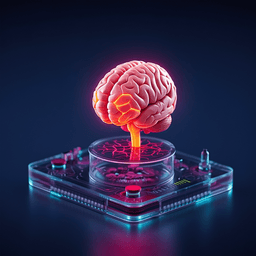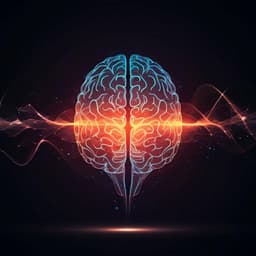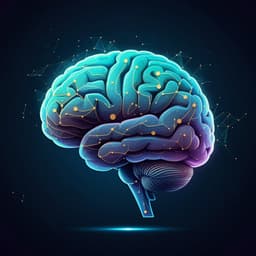
Medicine and Health
Human brain organoids: an innovative model for neurological disorder research and therapy
H. Li, J. Zhu, et al.
Human brain organoids (hBOs) are redefining brain research by recapitulating cellular diversity, architecture, and connectivity to advance diagnosis and treatment of Alzheimer’s, Parkinson’s, and related disorders. Combining patient-derived iPSCs with gene-editing enables precise mechanistic studies and scalable drug screening; this review, conducted by the authors listed in the <Authors> tag, outlines advantages, limitations, and therapeutic potential.
~3 min • Beginner • English
Introduction
The review addresses the challenge of modeling complex, human-specific neurological disorders due to the brain’s exceptional cellular diversity and intricate 3D synaptic architecture. Traditional 2D cultures and animal models, while valuable, lack the species-specific features and spatial organization of the human brain, limiting translational relevance. Advances in pluripotent stem cell technologies enabled the generation of organoids resembling organ-specific structures; human brain organoids (hBOs) derived from hPSCs (ESCs, iPSCs) self-organize into 3D structures capturing key developmental and functional features. Since early milestones beginning in 1992, improvements have expanded applications in neurodevelopment and neuropathology. hBOs offer superior fidelity for disease modeling, drug screening, and personalized medicine. However, limitations include restricted vascularization, inter-organoid heterogeneity, hypoxic cores, increased cellular stress, lack of inter-organ interactions, and ethical concerns, which constrain modeling of late-stage disease. The review explores strategies to address these gaps and enhance the biological fidelity and clinical relevance of hBO platforms.
Literature Review
The mini review synthesizes recent advances in hBOs across multiple domains: (1) Modeling the neural microenvironment: hBOs in 3D produce ECMs that support autocrine/paracrine signaling and more physiologic cell behaviors; artificial ECMs (Matrigel, Geltrex) and bioengineering improvements (vascular-like networks, extended culture stability) enhance physiological accuracy. Integration of neuroimmune components, in vivo transplantation, and multi-region/multi-organ systems improves systemic modeling and translational relevance. (2) Unguided vs guided hBOs: Unguided hBOs self-organize into heterogeneous regions but suffer from variability; they are suitable for early developmental disorders (microcephaly, Zika). Guided hBOs use patterning cues to enrich region-specific identities (cortex, midbrain, hypothalamus), improving reproducibility and targeting disease (e.g., PD in midbrain organoids; AD pathology in cortical organoids). Hybrid assembloids fuse region-specific organoids to model inter-regional interactions. (3) Multi-omics integration: Combining scRNA-seq, proteomics, phosphoproteomics, and epigenomics (ATAC-seq, DNA methylation) with hBOs decodes ND mechanisms, reveals cell-type heterogeneity and signaling disruptions (e.g., Wnt in ASD, neuroinflammation in AD), identifies post-translational modifications (tau hyperphosphorylation), and tracks pathways (NF-κB, PI3K-Akt). (4) Applications: Disease modeling and therapeutic innovation in AD, PD, ALS, ASD, AMS, epilepsy, and brain tumors; comparison with other platforms (animal chimeras, brain-on-a-chip, 2D cultures/iPSC neurons) highlights hBOs’ superior structural fidelity and patient-specific relevance. (5) Bioengineering strategies: Neuroimmune hBO models with microglia, hBO-rodent transplantation for maturation and therapeutic validation, and organoid assemblies for inter-regional and inter-organ communication, each with distinct advantages and limitations.
Methodology
This is a mini review synthesizing published literature. The authors: (a) summarize historical milestones (1992–2024) in hBO development and culture optimization; (b) compare five neural modeling platforms (3D hBOs, animal chimeras, brain-on-a-chip, 2D cultures/primary neurons, 2D iPSC-derived neurons) highlighting advantages, limitations, and translational potential; (c) categorize hBO approaches into unguided vs guided strategies, and discuss hybrid assembloids; (d) integrate multi-omics evidence (scRNA-seq, proteomics/phosphoproteomics, ATAC-seq, DNA methylation) to elucidate disease mechanisms; and (e) compile bioengineering enhancements (neuroimmune integration, transplantation, organoid assemblies) with representative studies (Tables 1–2; Figures 1–3). No new experiments were conducted; the methodology entails qualitative synthesis and comparative analysis of prior studies.
Key Findings
- hBOs outperform traditional 2D cultures and animal models in replicating human-specific brain architecture and microenvironment, enabling realistic cell-cell interactions and patient-specific phenotypes for neurodevelopment and ND research. - Multi-omics with hBOs reveals disease mechanisms: scRNA-seq identifies cell-type heterogeneity and pathway disruptions (e.g., Wnt signaling in ASD); proteomics/phosphoproteomics detect tau hyperphosphorylation in AD; ATAC-seq shows reduced enhancer activity in apoptosis-related genes in AD; integrated analyses track NF-κB and PI3K-Akt pathways. - Alzheimer’s disease: hBOs exposed to AD patient serum recapitulate elevated P-Tau, Aβ aggregation, network disruption, synaptic degeneration; Aβ42 administration leads to time-dependent plaque formation. Zika virus activates PERK/eIF2α pathway causing AD-like features; PERK inhibition alleviates pathology. APOEɛ4/ɛ4 hBOs show increased apoptosis, reduced synapses, exacerbated tau phosphorylation; isogenic APOE4→APOE3 conversion attenuates these phenotypes. APOE3 Christchurch modulates β-catenin/Wnt signaling and reduces tau pathology. β- and γ-secretase inhibitors reduce amyloid and tau in familial AD hBO models. - Parkinson’s disease: SNCA triplication organoids show α-synuclein aggregates and dopaminergic degeneration. PRKN-mutant hBOs exhibit reduced astrocyte populations. LRRK2 mutations reproduce dopaminergic loss and Lewy bodies; LRRK2 knockout recapitulates PD pathology. DNAJC6 mutations impair WNT signaling, increase α-synuclein, and disrupt autophagy-lysosomal function. 2-hydroxypropyl-β-cyclodextrin (2-HP-β-CD) improves mitochondrial function and autophagy in PINK1-mutant hBOs, reducing degeneration and necrosis. Transplanted human midbrain organoids integrate into mouse striatum circuits and restore motor function, supporting cell-replacement therapy. - ALS: C9ORF72 hBO slice cultures display early astroglial P62 accumulation, poly(GA) aggregates, DNA damage, and neuronal nuclear pyknosis; PERK inhibitor GSK2606414 partially rescues phenotypes. TDP-43 aggregates spread intercellularly, triggering astrocyte proliferation, DNA double-strand breaks, and cell death. GRN-deficient astrocytes induce TDP-43 hyperphosphorylation/misfolding, modeling TDP-43 proteinopathy. Microglia-containing hBOs elucidate glial interactions in ALS pathogenesis. - ASD and AMS: RAB39B deletion causes macrocephaly-like phenotypes via PI3K-AKT-mTOR hyperactivation, with increased hBO volume, excessive NPC proliferation, thickened SOX2+ ventricular zones, and impaired differentiation. CHD8 deficiency affects ASD gene networks (TCF4, AUTS2), Wnt/β-catenin signaling, and GABAergic differentiation. ASD hBOs show accelerated NPC cycles, overproduction of GABAergic neurons, and E/I imbalance potentially driven by FOXG1. Disruptions in developmental gene networks prime premature neuronal differentiation; β-catenin/BRN2 axis dysregulation leads to synaptic transmission deficits. AMS models (CDK5RAP2, NARS1, CPAP, WDR62 mutations) show impaired NPC proliferation, premature differentiation, defective cell-cycle progression, reduced outer radial glia proliferation, and neurogenesis defects. - Epilepsy: hBOs integrated with MEA reveal impaired plasticity and aberrant circuit information processing; genetic epilepsy hBOs reproduce hyperexcitability and drug responsiveness; CDKL5-deficient hBOs model early hyperexcitability followed by late hypoexcitability, both reversible by pharmacological or gene therapy interventions. - Brain tumors: GSC-hBO co-cultures model GBM with deep infiltration and tumor-like masses; in medulloblastoma, SMARCA4 suppresses OTX2/MYC oncogenic axis; EZH2 inhibitor reduces OTX2/MYC-driven tumorigenesis in hBOs. - Bioengineering strategies (microglia integration, vascularization, transplantation, assembloids, multi-organ integration) enhance maturation, immune context, connectivity, and systemic modeling, improving translational relevance.
Discussion
The review demonstrates that hBOs bridge critical gaps in neuroscience by recapitulating human-specific brain structure, cell diversity, and network function, enabling mechanistic insights and therapeutic discovery for ND. Integrating multi-omics elevates hBOs from static models to dynamic platforms that resolve cell-state heterogeneity, signaling dysregulation, and gene regulatory changes underlying disease. Guided differentiation enhances reproducibility and region specificity, while unguided and hybrid assembloids capture broader developmental features and inter-regional interactions, expanding utility for network-level dysfunctions. The disease exemplars (AD, PD, ALS, ASD, AMS, epilepsy, brain tumors) show that hBOs can reproduce hallmark pathologies, validate genetic drivers, and support intervention testing (e.g., PERK inhibitors, secretase inhibitors, 2-HP-β-CD, EZH2 inhibition, APOE editing). Transplantation studies highlight potential for cell-based therapies and in vivo maturation. Nonetheless, current limitations—vascularization deficits, immature glia and oligodendrocytes, batch variability, ethical concerns, and limited systemic context—temper translational readiness. Continued standardization, incorporation of neuroimmune and vascular components, assembloid and multi-organ integration, and rigorous quality control will be essential to enhance physiological relevance and reproducibility, ultimately advancing precision neurology and targeted neurotherapeutics.
Conclusion
Human brain organoids are transformative models for neurological disorder research and therapy, offering superior structural fidelity and human-specific relevance compared to 2D cultures and animal models. This mini review consolidates evidence that hBOs, especially when paired with multi-omics, gene editing, and bioengineering, can elucidate mechanisms and support drug screening across AD, PD, ALS, ASD, AMS, epilepsy, and brain tumors. Key future directions include: standardization of protocols and quality metrics; enhancement of vascularization and immune components; maturation of microglia and oligodendrocytes; development of assembloids and multi-organ systems; and ethical frameworks for translational use. Progress in these areas will unlock the diagnostic and therapeutic potential of hBOs in precision neuroscience.
Limitations
- Lack of functional vasculature leading to insufficient nutrient diffusion and hypoxic cores. - Inter-organoid heterogeneity and batch-to-batch variability driven by stem cell sources, reagent quality, and manual handling. - Incomplete neuronal maturation and limited capacity to model late-stage diseases. - Absence or immaturity of key cell types (microglia, mature oligodendrocytes) and incomplete neural circuitry. - Restricted inter-organ interactions, limiting systemic disease modeling. - Ethical and legal concerns, especially for transplantation and chimeric models. - Technical complexity, instability, and lack of standardized, scalable protocols.
Related Publications
Explore these studies to deepen your understanding of the subject.







